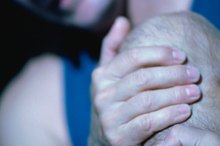Causes of Pain in the Upper Left Hip
Numerous conditions can cause pain in the upper left hip. Hip pain may be felt in one or both hips, depending on the cause of the pain and the tissues involved. Determining the source of pain can be difficult, as hip-related pain may be felt in the hip joint, the middle of the thigh or the groin, according to MedlinePlus, a service of the National Institutes of Health 1. Hip pain may also be caused by a problem in the back or pelvis, further complicating the diagnosis.
If you are experiencing serious medical symptoms, seek emergency treatment immediately.
Dislocated Hip
A dislocated left hip can cause pain in the upper left hip area. According to the American Academy of Orthopaedic Surgeons, a dislocated hip occurs when the head of the femur of thigh bone slips from or is forced out of the hip joint or socket 2. Most hip dislocations involve a backward and downward slippage of the head of the femur. A dislocated hip can cause extreme pain and immobility. In some cases, nearby nerves may be damaged, causing a loss of sensation in the foot and ankle on the affected side. Possible causes of a dislocated hip include motor vehicle accidents or a fall from great height. The AAOS states that, because it requires a considerable amount of force to dislocate the hip, other injuries--such as head wounds, pelvic fractures or back problems--may also occur during the injury. If no other complications are present, a physician will administer a sedative and reduce or re-approximate the affected bones.
- A dislocated left hip can cause pain in the upper left hip area.
- According to the American Academy of Orthopaedic Surgeons, a dislocated hip occurs when the head of the femur of thigh bone slips from or is forced out of the hip joint or socket 2.
Hip Bursitis
Causes of Pain on the Right Side of the Neck Down to the Shoulder
Learn More
Hip bursitis can cause pain in the upper left hip region. Bursitis is a painful swelling and inflammation of a bursa--a fluid-filled sac located between ligament or tendons and bone that help reduce friction between these structures during movement. The Sports Injury Clinic notes that there are several types of hip bursitis, including trochanteric, gluteus medius, iliopsoas and ischial bursitis, which are named based on their anatomical location 3. The most commonly injured hip-related bursa is the trochanteric bursa, which is located on the outside aspect of the upper hip, between the greater trochanter of the femur and the tendons of the gluteal muscles. The trochanteric bursa can be injured by direct trauma or excessive friction due to repetitive movement. Common signs and symptoms associated with hip bursitis include pain on the upper outside aspect of the hip, tenderness in the affected area and pain that radiates down the outer thigh.
- Hip bursitis can cause pain in the upper left hip region.
- Common signs and symptoms associated with hip bursitis include pain on the upper outside aspect of the hip, tenderness in the affected area and pain that radiates down the outer thigh.
Avascular Necrosis
Avascular necrosis, also known as osteonecrosis, can cause pain in the upper left hip 4. According to MayoClinic.com, avascular necrosis involves the death of bone tissue 4. The affected bone tissue dies due to insufficient blood supply. Fractures and bone collapse are common complications caused by avascular necrosis 4. Possible causes of avascular necrosis or an interruption of blood flow to the bone include joint dislocation, certain steroid medications and alcoholism 4. MayoClinic.com states that the hip joint is the most commonly affected joint, and that avascular necrosis usually progresses or worsens over time 4. Common signs and symptoms associated with avascular necrosis include pain in the hip joint, reduced hip joint active range of motion and pain that radiates from the hip to the groin or down the thigh to the knee 4. Certain medical conditions are associated with bone death, including diabetes, Gaucher's disease and HIV.
Related Articles
References
Writer Bio
Martin Hughes is a chiropractic physician, health writer and the co-owner of a website devoted to natural footgear. He writes about health, fitness, diet and lifestyle. Hughes earned his Bachelor of Science in kinesiology at the University of Waterloo and his doctoral degree from Western States Chiropractic College in Portland, Ore.









